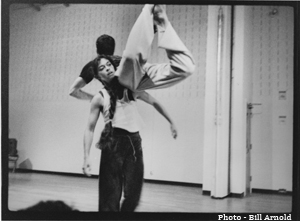Underscore description
The Underscore incorporates descriptions of the significant states of mind and movement that naturally appear within Contact Improvisation. It was developed by Nancy Stark Smith, who was in the original group of dancers who worked closely with Steve Paxton in developing Contact Improvisation.
The emergence of the Underscore was a gradual process that started in 1990, following a feeling of claustrophobia felt by Nancy Stark Smith regarding her teaching practice. This came after 15 years of amassing a wealth of knowledge, skills and techniques based on Contact Improvisation, which had become a prescriptive list of content that she felt needed to be touched on within her classes. Stark Smith then began to question where the “constant sense of discovery, the invention of materials and methods of the early years…” (Koteen, Smith, Paxton, 2008, p. 91) had gone?
As a result, Stark Smith began to rebel against this self-imposed list of session requirements by introducing periods of open spaces for movement exploration. Progressively, the classes evolved into a combination of open spaces and spoken and/or demonstrated instruction that focused the activity. To Stark Smith, these directed moments were “occurring in a seemingly random, intuitively determined order” (Koteen, Smith, Paxton, 2008, p. 93). It was only after students began to ask questions relating to “that part of the class”, when Stark Smith started to acknowledge, that rather than her classes being an assemblage of random exercises, an underlying score consistently informed her decision-making process. The question of “what was this under pinning logic that existed throughout the classes?” (Dancetechtv, 2012), led to the eventual uncovering of what was to become known later as the Underscore.
While Stark Smith sees the Underscore primarily as a research tool and a way of studying phenomena in dance improvisation, including changes of state of mind and physicality, she accepts that:
People like to do the Underscore because it is like a container for the
improvisation. It helps to focus the practice even though it is quite open. It
offers the dancers the opportunity to go through the different states
uninterrupted and as a group, so as to feel what that is like and what that
generates, rather than a more random jam environment. (Dancetechtv, 2012).
Stark Smith feels that the framework reflects a middle ground between being prescriptive and descriptive, suggesting what to do while at the same time offering a description of commonly experienced states of awareness (Koteen, Smith, Paxton, 2008, p.98).
